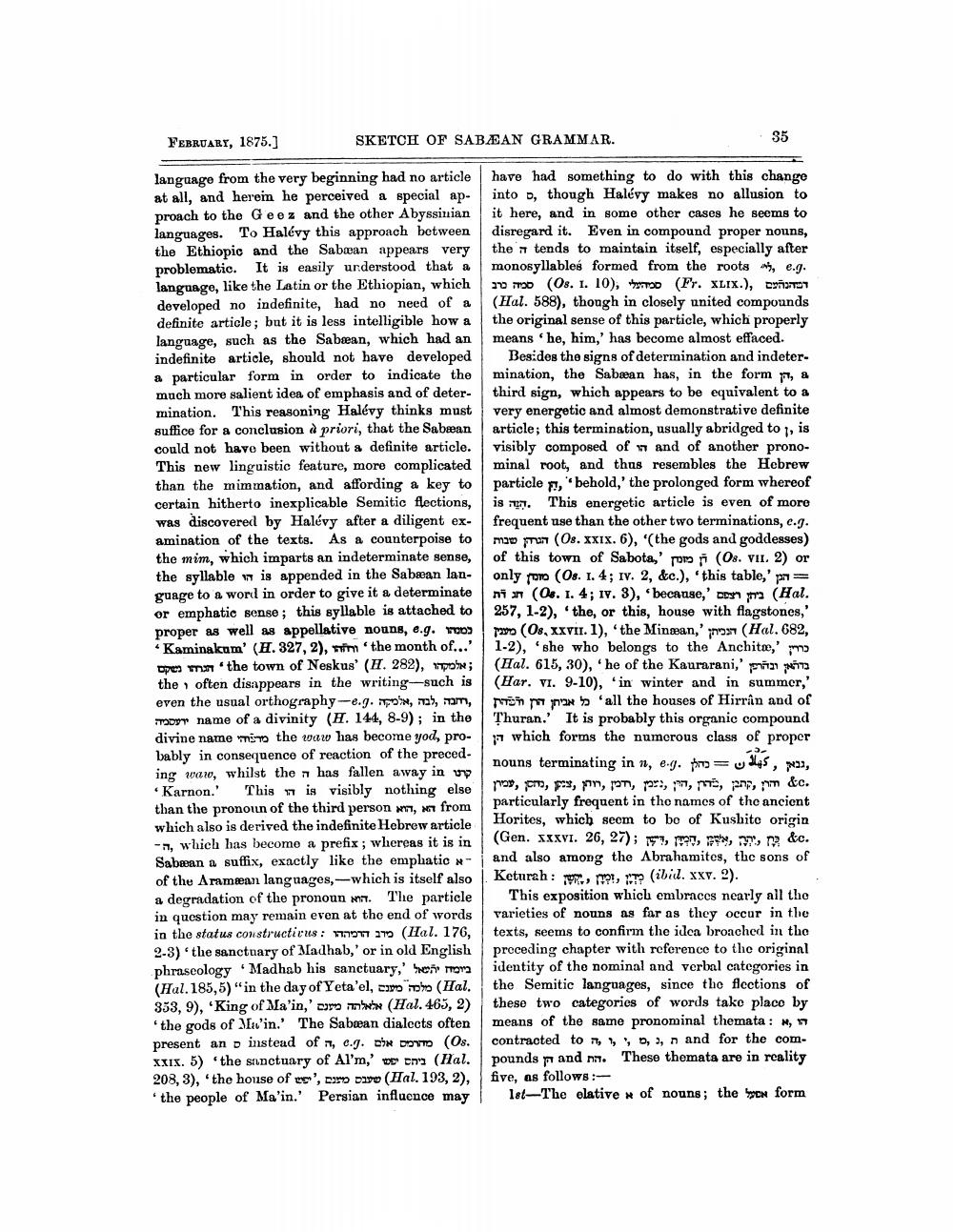________________
FEBRUARY, 1875.]
SKETCH OF SABÆAN GRAMMAR.
35
language from the very beginning had no article at all, and herein he perceived a special ap- proach to the Geez and the other Abyssinian languages. To Halévy this approach between the Ethiopia and the Sabwan appears very problematic. It is easily urderstood that a language, like the Latin or the Ethiopian, which developed no indefinite, had no need of a definite article; but it is less intelligible how a language, such as the Sabran, which had an indefinite article, should not have developed a particular form in order to indicate the much more salient idea of emphasis and of deter- mination. This reasoning Halévy thinks must suffice for a conclusion à priori, that the Sabæan could not have been without a definite article. This new linguistic feature, more complicated than the mimmation, and affording a key to certain hitherto inexplicable Semitic flections, was discovered by Halévy after a diligent examination of the texts. As a counterpoise to the mim, which imparts an indeterminate sense, the syllable wis appended in the Sabwan language to a word in order to give it a determinate or emphatic sense ; this syllable is attached to proper as well as appellative nouns, e.g. To * Kaminakum' (H. 327, 2), in the month of...'
pesma the town of Neskus' (H. 282), mon; the often disappears in the writing-such is even the usual orthography-e.g. Fox, rah, mam, TODyr name of a divinity (H. 144, 8-9); in the divine name minto the raw has become yod, probably in consequence of reaction of the preceding war, whilst then has fallen away in my • Karnon. This is visibly nothing else than the pronoun of the third person 77, 7 from which also is derived the indefinite Hebrew article -7, which has become a prefix; whereas it is in Sabæan a suffix, exactly like the emphatic - of the Aramean languages, which is itself also a degradation of the pronoun n. The particle in question may remain even at the end of words in the status constructicus: mom 270 (Hal. 176, 2-3) the sanctuary of Madhab,' or in old English phraseology Madhab his sanctuary,' het tona (Hal. 185,5) "in the day of Yeta'el, capo (Hal. 353, 9), 'King of Ma'in,' crow' (Hal. 465, 2) *the gods of M in.' The Sabuan dialects often present an instead of r, c.9. E' YTO (Os. XXIX. 5) 'the sanctuary of Al'm,' weens (Hal. 208, 3), 'the house of ec', no I (Hal. 193, 2), the people of Ma'in.' Persian influence may
have had something to do with this change into o, though Halévy makes no allusion to it here, and in some other cases he seems to disregard it. Even in compound proper nouns, the tends to maintain itself, especially after monosyllables formed from the roots , e.. 20 7730 (Os. 1. 10), D (Fr. XLIX.), D OT (Hal. 588), though in closely united compounds the original sense of this particle, which properly means 'he, him,' has become almost effaced.
Besides the signs of determination and indetermination, the Sabæan has, in the form , a third sign, which appears to be equivalent to a very energetic and almost demonstrative definite article; this termination, usually abridged to , is visibly composed of and of another pronominal root, and thus resembles the Hebrew particle p., behold,' the prolonged form whereof is . This energetic article is even of more frequent use than the other two terminations, e.g. mao prian (Os. xxix. 6), '(the gods and goddesses) of this town of Sabota,' rom (Os. Vir. 2) or only romo (Os. 1. 4; rv. 2, &c.), 'this table,' p = nian (Os. 1. 4; 1v. 3), “because,' pesam (Hal. 257, 1-2), the, or this, house with flagstones,' tao (Os, xxvir. 1), the Minman,'non (Hal. 682, 1-2), she who belongs to the Anchito, ma (Hal. 615, 30), 'he of the Kaurarani,' in it (Har. vi. 9-10), in winter and in summer, men m an all the houses of Hirrân and of Thuran.' It is probably this organic compound 17 which forms the numerous class of proper nouns terminating in n, eg. tro= 45, , poy, go, ps, pin, por, pr., , , 2n, &c. particularly frequent in the names of the ancient Horites, which seem to be of Kushito origin (Gen. XXXVI. 26, 27); 95 m, , 97, 9&c. and also among the Abrahamites, the sons of Keturah: mp, 170 (ibil. xxv. 2).
This exposition which embraces nearly all the varieties of nouns as far as they occur in the texts, seems to confirm the idea broached in the preceding chapter with reference to the original identity of the nominal and verbal categories in the Semitic languages, since the flections of these two categories of words take place by means of the same pronominal themata : Nem contracted to 1, 1 0, 3, n and for the compounds p and na. These themata are in reality five, as follows:
let-The elative # of nouns; the byen form




